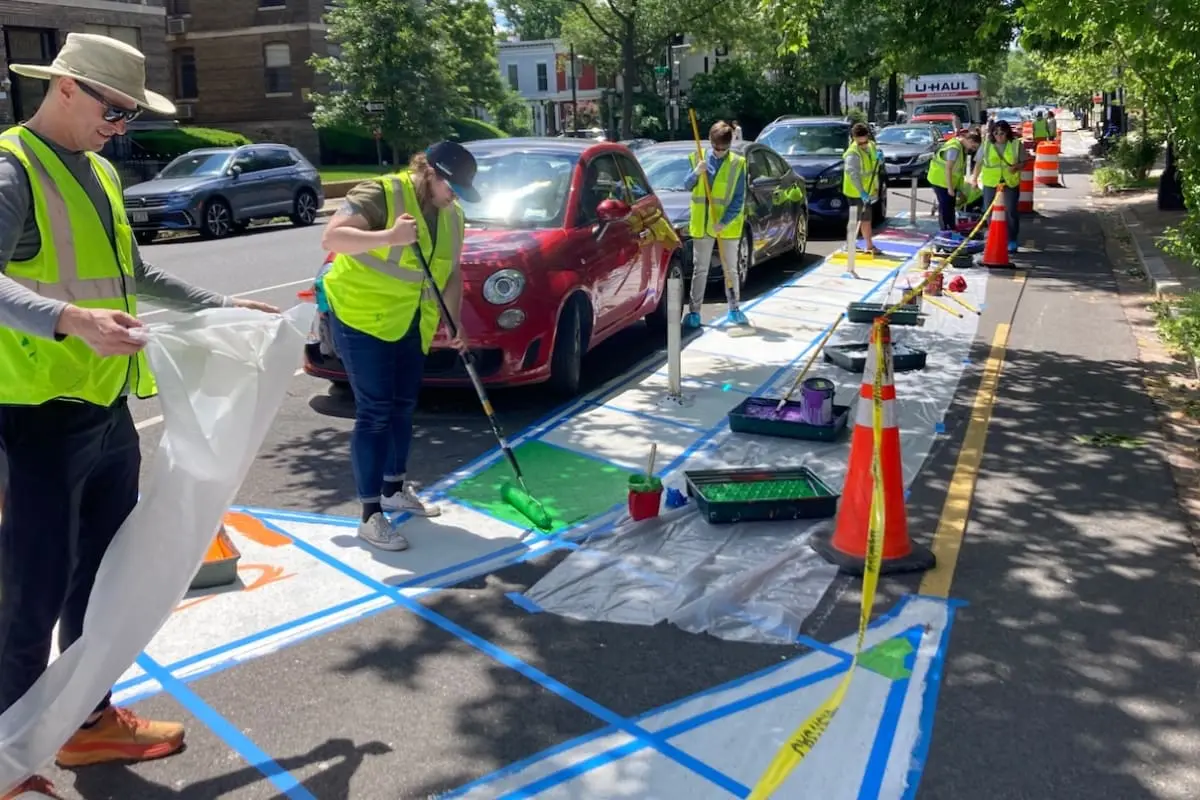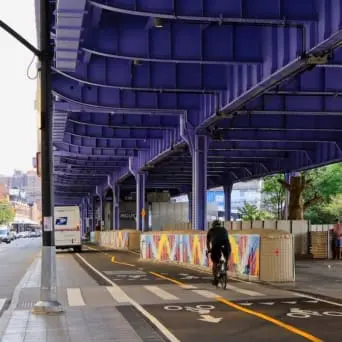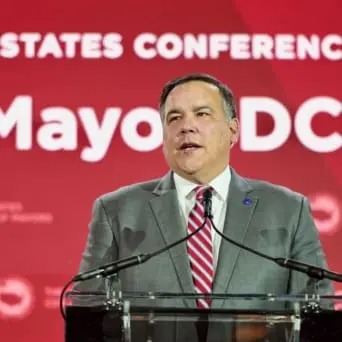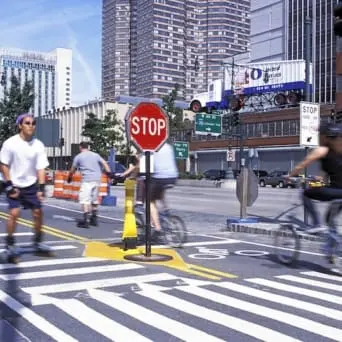By Raveena John
Opposition to Complete Streets is often rooted in misconceptions or overstated concerns about vehicle access, economic vitality, and traffic congestion. While not all objections are raised in good faith, some deserve thoughtful, evidence-based responses. This article addresses some common myths, providing real-world examples, and actionable solutions to help cities adopt and implement Complete Streets policies that promote safety, equity, and public health.
Myth #1: Complete Streets Lead to More Traffic Congestion
Reality: Complete Streets don’t increase congestion, and may even improve it
Complete Streets aren’t about slowing people down — they’re about moving everyone more safely and efficiently. Features like dedicated bus lanes, improved crosswalks, and traffic-calming measures help balance flow while enhancing safety. Rather than increasing congestion, cities can actually reduce the number of cars on the road as many shorter trips are replaced by walking, biking, transit, and other modes. Cities have seen traffic volumes stabilize or even decrease after implementing Complete Streets, especially when paired with smart signal timing and better curbside management. The result? Streets that work better for drivers and non-drivers alike.
For decades, roadways have been expanded under the promise of reducing congestion, only to induce demand and fail to meet the needs of all transportation users. Transportation decisions should align with a city’s full priorities, instead of narrowly focusing on trying to move cars quickly. Downtowns should be places that everyone can enjoy, whether they have access to a car or not. By implementing Complete Streets, communities can take advantage of a myriad of benefits to public health, safety, the environment, and economic development.
In San Francisco, after decades of opposition about altering the Embarcadero Freeway, the city finally replaced it with a multi-use boulevard which still allowed car traffic, but also featured a streetcar line, wide sidewalks, palm trees, and more. Rather than doing damage, traffic was absorbed by the street network. Furthermore, the area thrived following the boulevard creation. Commercial development accelerated, additional housing was built, and jobs increased significantly.
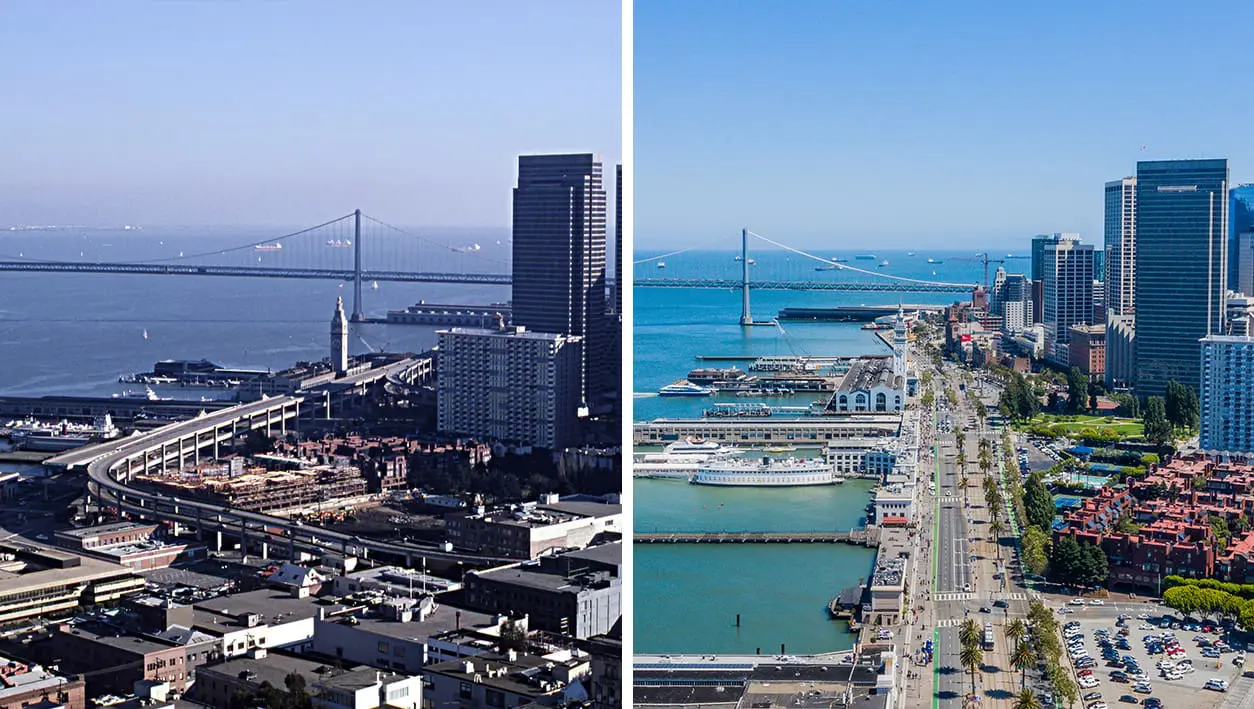
San Francisco Embarcadero before (left) and after (right) the freeway removal. (Source: Left, GeraldPHawkins, licensed under Creative Commons; right, iStockPhoto)
Myth #2: Complete Streets are Bad for Business
Reality: Complete Streets boost local economies
A concern about Complete Streets is the fear that this approach will negatively affect businesses. People worry that reducing room for cars will prevent patrons from accessing local businesses, based on the assumption that people need to drive to be able to shop. The opposite is true; rather than hurting business, Complete Streets can be a catalyst for economic vitality. By creating safer, more inviting spaces for walking, biking, and transit, they increase foot traffic and encourage people to linger, shop, and dine locally. Features like better lighting, greenery, and accessible sidewalks enhance the overall shopping experience, attracting a broader customer base and supporting long-term neighborhood growth.
A recent study measured job growth, wage increases, new households, and development investment sparked by Complete Streets, suggesting that this approach is a strong community development strategy that can yield a 10:1 return on investment. The study also included specific case studies such as Tennyson Street in Denver which was transformed through rezoning and safety improvements for pedestrians and cyclists. Despite initial concerns, over a decade since the initial improvements, the area has hundreds of new residents and thriving businesses.
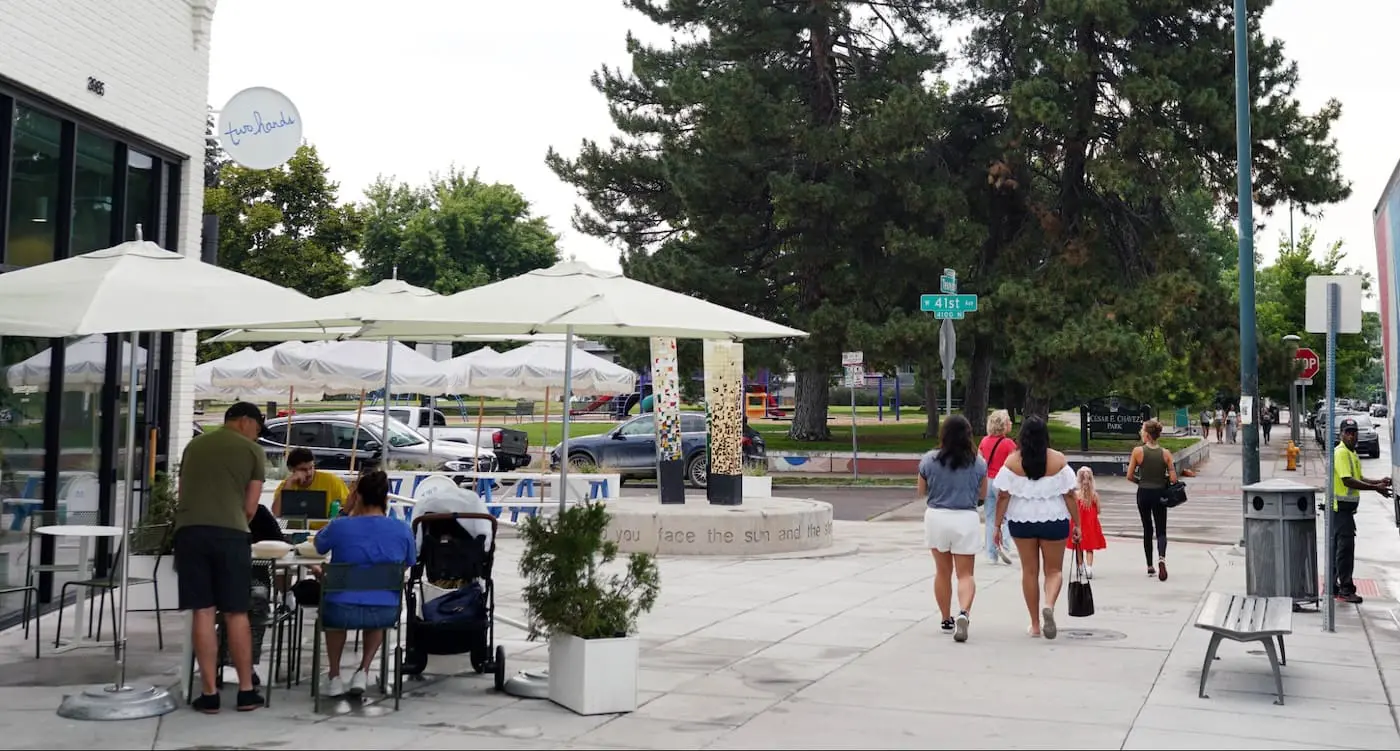
Pedestrians and restaurant customers on Tennyson Street near a community park. (Source: Smart Growth America)
Smart Growth America’s (SGA) report Safer Streets, Stronger Economies found that job and wage growth was associated with Complete Streets. Cities can build on this momentum and use this guide from the Victoria Transport Policy Institute for evaluating and communicating active transportation benefits to overcome these economic myths.

Pedestrians in Winchester, Virginia (Source: Smart Growth America)
Myth #3: Complete Streets Impede Maintenance Vehicles
Reality: Cities can update their maintenance strategies to fit a more inclusive street design and even reduce their maintenance needs.
A significant concern for many cities is how to clear snow, leaves, debris, and perform other maintenance. But cities can perform maintenance on Complete Streets using strategies like acquiring different maintenance vehicles and priority schedules. For example, the Minnesota Department of Transportation (MnDOT) recommends smaller vehicles and modified plows to clear bicycle lanes, delineators on curbs to guide plow drivers, and prioritization routes for strategic snow removal. For sweeping and debris removal, MnDOT recommends smaller and/or specialized sweepers. Maintenance needs will be different but not necessarily greater, since implementing Complete Streets can reduce the vehicle lanes, resulting in less area to maintain overall.
Numerous American cities such as Boston, Chicago, and Salt Lake City have used smaller vehicles and equipment to ensure proper maintenance of all street features. Careful assessment of their own features and internal collaboration between departments has allowed them to find the solutions that work for them.
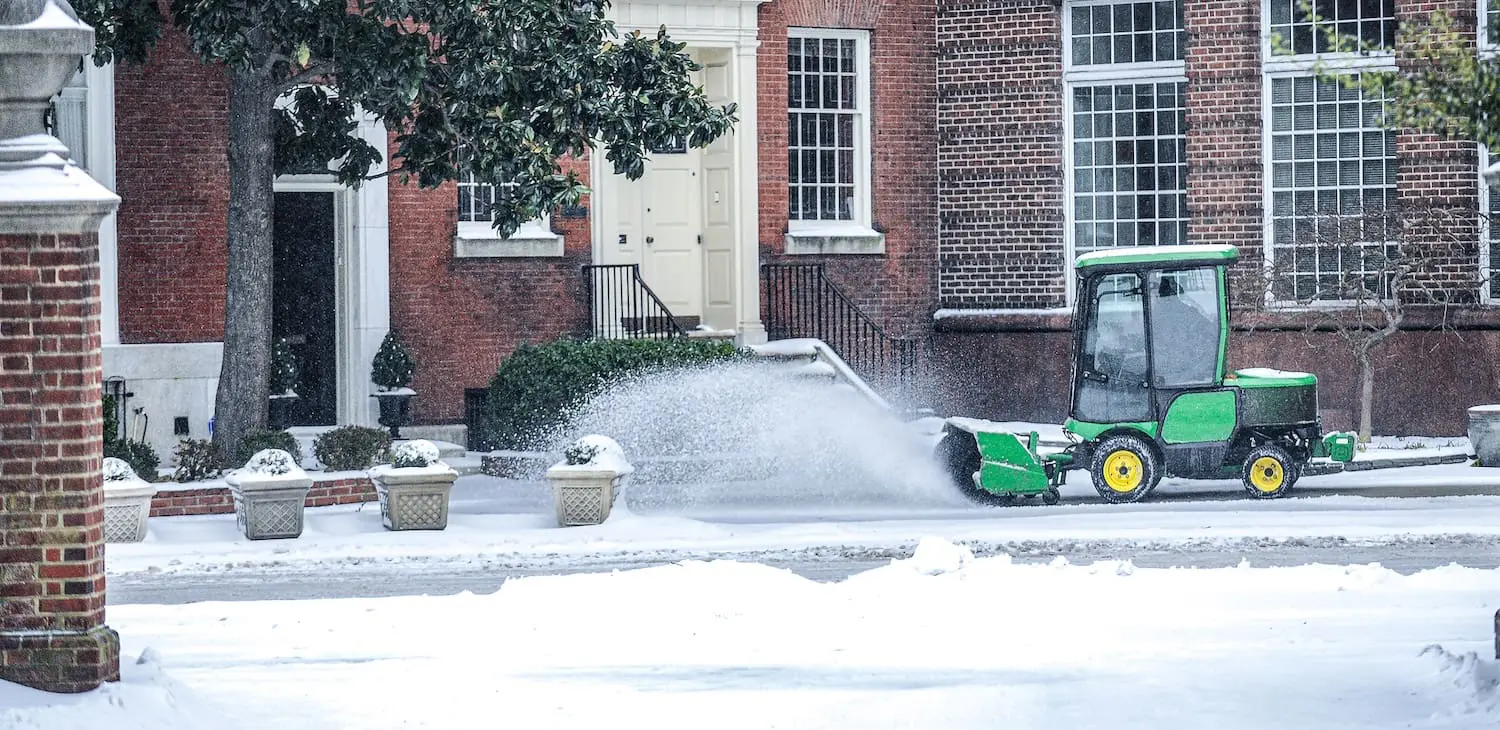
A small vehicle removing snow in Philadelphia. (Source: iStockPhoto)
Myth #4: Complete Streets Leave No Room for Delivery Trucks
Reality: Complete Streets offers an opportunity to create safer and more sustainable urban freight planning
Concerns about freight compatibility reflect broader questions about truck routing and urban logistics. While some worry that large vehicles like semi-trucks can’t navigate redesigned streets, thoughtful planning ensures that freight access is preserved where it’s needed. Cities can use tools like designated truck routes, turn radius modeling, and context-sensitive design features to maintain freight mobility without compromising street safety. In many cases, streets under consideration for redesign aren’t even part of the primary freight network—for example, Baltimore has regulations for freight trucks such as restrictions in some areas and designated routes for large vehicles.
There may also be concerns about how delivery vehicles will fit on a street with bike lanes and bus stops. Curbside management is a growing practice that can fit well with Complete Streets. Curb space is a valuable and finite resource, so cities should use the technologies at their disposal to best balance demands. For example, Washington, DC designates specific curbside loading zones and pick-up/drop-off zones. Urban freight planning is a growing field that looks at last-mile deliveries, particularly for emissions reductions, which helps cities understand the state of freight in their streets and to actively plan to make changes to how deliveries operate. These methods can work in conjunction with Complete Streets to move goods without sacrificing safety or mobility.

A pick-up/drop-off zone for Washington, D.C.’s curbside management plan (Source: Smart Growth America)
Myth #5: Complete Streets Slow Emergency Response
Reality: Complete Streets can enhance emergency response
Another common concern is the impact on emergency response vehicles and the fear that Complete Streets would lengthen emergency response times. While it is imperative that responders get to emergencies promptly, well-designed Complete Streets don’t obstruct emergency vehicles and can be created without compromising response times. Recent research suggests no difference in emergency response time before and after roadway design changes, including reductions in the number travel lanes. Collaboration with a city’s emergency services can prevent any conflicts and ensure smooth operations.
But there’s more to this story. According to data from the National Highway Traffic Safety Administration, there have been over 1.4 million emergency responses to traffic crashes in the U.S. in the past twelve months. Complete Streets improve safety for all road users and reduce the number and severity of crashes. Some communities are using the shared goal of crash prevention to align the efforts of Complete Streets and emergency responders. In Berkeley, CA, local street safety advocates and firefighters are working together and have created a new role of “Street Trauma Prevention program manager” to expand the fire department’s support of crash prevention (for example by improving street designs and focusing on the most vulnerable road users like bicyclists and pedestrians), in addition to crash response.
There is precedent here: in the 1970s, federal and local efforts shifted toward fire prevention, which led to a dramatic decline in deaths from fires in the U.S. Nearby, the San Francisco Fire Department helps implement the city’s Vision Zero plan by including smaller trucks in their fleet, which can navigate safer, narrow lanes. These examples show that Complete Streets and emergency services need not be viewed as oppositional. On the contrary, they can work well together and make important improvements that enhance safety and service for all.
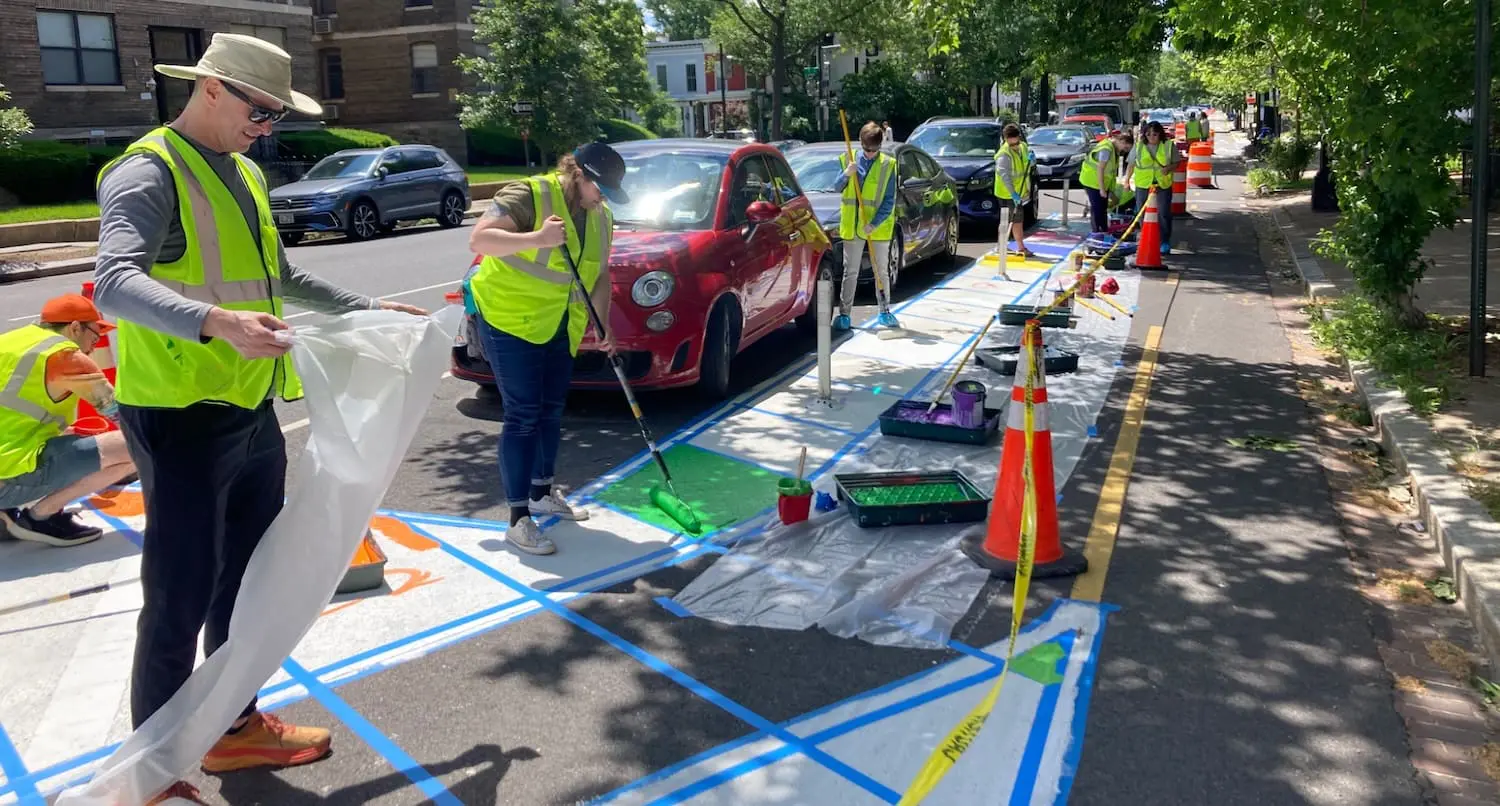
Painting a protected bike lane in Washington, D.C. (Source: Smart Growth America)
Don’t let these myths get in the way of creating a strong policy!
Cities across the country are adopting and implementing strong Complete Streets policies. Check out CityHealth’s resources for more information and helpful tools like the Complete Streets Policy Action Guide — a step-by-step manual for creating a great policy!
Raveena John is a senior program associate at Smart Growth America

